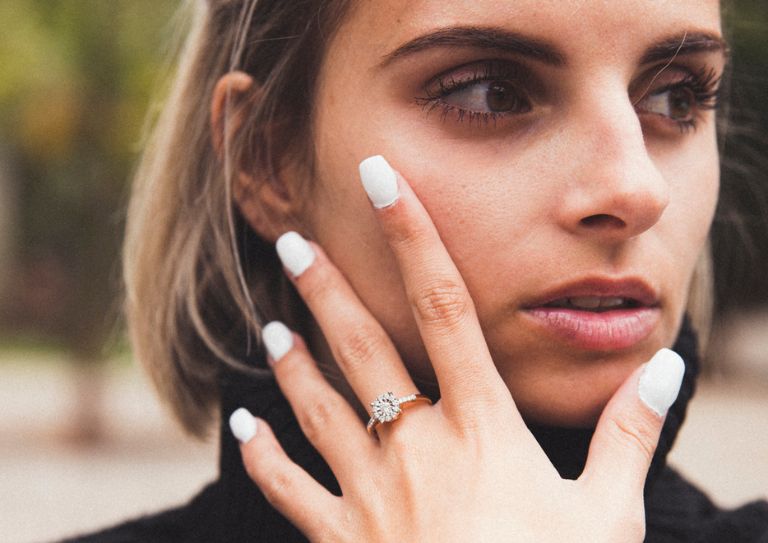The symmetrical combination of elements that give diamonds their various forms is the cut. Making a decision on a diamond’s cut is crucial because it is what affects a diamond’s brightness the most.
For this reason, we’ve elaborated this guide to help you decide which cut suits you best:
Types of diamond cuts
- Round cuts: The most famous diamond cut is well-known for its symmetrical shape and excellent light dispersion. It has 57 to 58 sides, commonly known as facets or aspects, including the culet, which reflect light brilliantly better than most other shapes.
- Marquise cuts: This cut has the most surface area of any diamond shape thanks to its 58 facets and elongated shape, which gives the finger a long and slim appearance.
- Princess cuts: This cut is the second most famous cut after the round cut. With 57 to 60 facets, Princess Cuts are very popular among engagement rings.
- Oval cuts: If we combine the Round and Marquise cut, the result would be the Oval cut. This lovely shape of 57 to 58 facets has a large surface area that can compliment a wide range of hand shapes. This cut has been crafted by jewel cutters for centuries, but it was Lazare Kaplan who made it get its actual reputation.
- Pear cuts: The Pear Cut diamond is an exquisite, lovely, and brilliant cut of diamond that combines the cut qualities of the Round Brilliant diamond and the opulent Marquise Cut diamond. When given to the one you love, this diamond cut, also referred to as a “teardrop,” will undoubtedly cause them to shed a tear of happiness.
- Cushion cuts: These pillow-fashioned diamonds have 58 facets, rounded corners and rectangular or square shapes. Cushion Cut diamonds sparkle like vintage diamonds with vast flashes of mild instead of the disco ball sparkle of present-day brilliant stones. The curved edges reflect the rainbow colors and are more durable. Cushion-cut diamonds come in various styles, from classic to modern.
- Radiant cuts: The radiant shape is a stunningly symmetrical, non-traditional cut that blends the radiance of a round cut with the purity of an emerald cut. Because of its 70 facets, the radiant is one of the shiniest diamond cuts; it has a flaming appearance while keeping gentle, carved corners. For buyers who prefer the emerald-cut form but want something with the sparkle of a round, a rectangle radiant cut is a fantastic choice. A square will result from a ratio of 1.00 to 1.05, whereas a rectangle will result from a ratio of 1.30 to 1.50.
- Asscher Cut: Nearly octagonal in shape due to its curving edges, offers a classic, modest look. Step-cut facets give the stone a gentle light that radiates outward. With X-shaped facets extending from its corners to its central culet, it combines the princess and emerald cuts. The step cut is perfect for showing diamonds with better clarity since it draws attention to the stone’s clarity. Certain inclusions and lesser colour grades may be concealed by the faceting. Its recommended cut ratio for square proportions is between 1 and 1.
- Emerald cuts: One of the first diamond shapes ever created, it is ideal for both fine diamonds and colourful gemstones. The emerald cut, also called a “step cut” because to its tiered faceting, has a distinctive appeal and symmetrical shine. Because of the minimum and straightforward faceting, inclusions frequently become visible. With lower colours, closed or bezel-style settings are advised because an open setting can also reveal the diamond’s colour. Because the emerald cut style highlights the stone’s colour, it is wise to use a high-quality diamond while making this choice.
- Heart cuts: This spectacular diamond shape, which is among the hardest to cut, has between 56 and 58 facets and is stunning to look at. A diamond with a beautiful heart shape and brilliant cut is the perfect way to communicate “I love you.”
- Trillion cuts: Also known as a trilliant cut, is a diamond with a triangular shape. A typical trillion cut diamond will have three equal-length sides and a flat table on its surface.

Cuts Grading Scale
A diamond crystal with a poor cut may appear dull; even if it has an excellent hue and appearance, cut grade is an important factor in comparing the overall appearance of a gem. The Gemological Institute of America (GIA) rates diamond cuts as follows.
- Excellent (EX). This is the highest quality grade. These crystals have produced a high level of scintillation and brilliance in darkish and brilliant sections.
- Very Good (VG). This grade of crystal has a great scintillation and brilliance, with darker areas in the middle and across the corners.
- Good (G). Diamond is darker and lacks scintillation.
- Fair (F). The diamond crystal sparkles somewhat and has a fully darkish ring across the girdle.
- Poor (P). It is the poorest cut grade, with crystals displaying minimal brightness or scintillation.
Any pieces of jewellery, such as a spectacular ring or necklace, benefits from a diamond cut. Since crystal cutting enhances the brilliance and lustre of raw and uncut stones, it’s important to make sure that we’re buying diamonds from reliable sellers like MJjewels.
There will be no further charges once your jewelry has been purchased. MJjewels is responsible for all tax expenses as well as all customs fees.
The total cost of purchase you see on the MJjewels website is the final total of all the jewelry. I.e., no hidden charges on all purchases. The very last fee is the only proven on the website. MJjewels is chargeable for any tax expenditures.
We control all of our diamonds, including the mining and distribution processes, to ensure that they are ethical and conflict-free. A Certificate of Authenticity is given to the recipient with each purchase. Professional assistance is also available at all times in case you have any doubts or questions. Jewelry specialists are always accessible to give details of your order.







